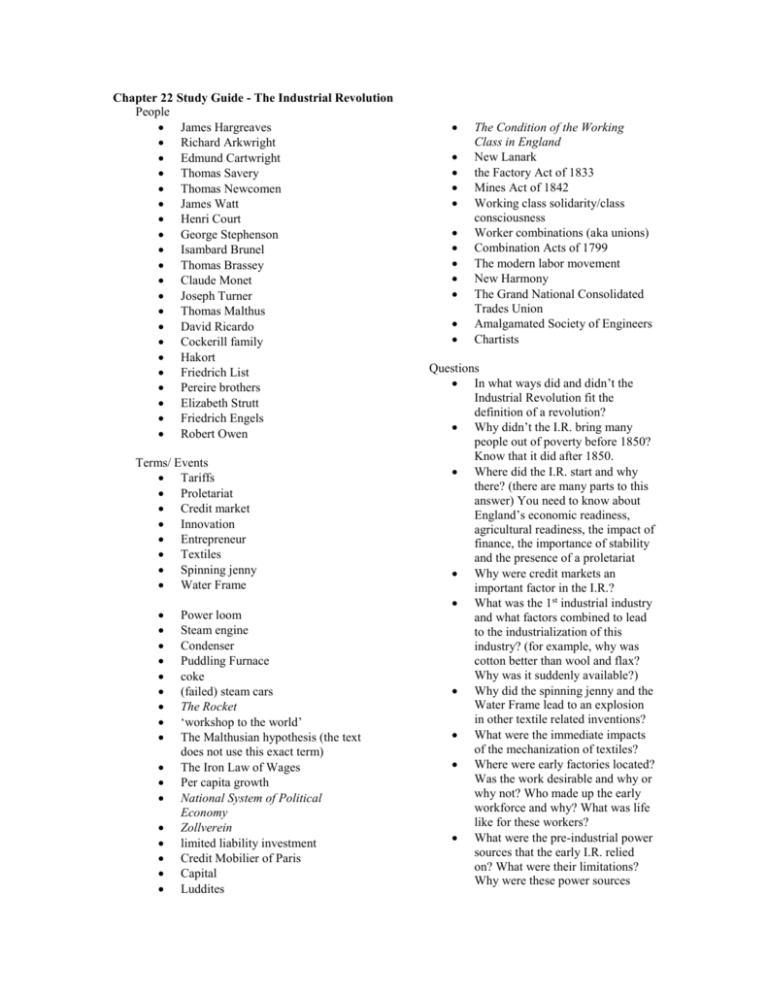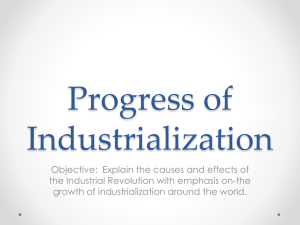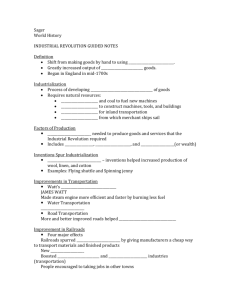Chapter 22 Tiered Notes- The Industrial Revolution
advertisement

Chapter 22 Study Guide - The Industrial Revolution People James Hargreaves Richard Arkwright Edmund Cartwright Thomas Savery Thomas Newcomen James Watt Henri Court George Stephenson Isambard Brunel Thomas Brassey Claude Monet Joseph Turner Thomas Malthus David Ricardo Cockerill family Hakort Friedrich List Pereire brothers Elizabeth Strutt Friedrich Engels Robert Owen Terms/ Events Tariffs Proletariat Credit market Innovation Entrepreneur Textiles Spinning jenny Water Frame Power loom Steam engine Condenser Puddling Furnace coke (failed) steam cars The Rocket ‘workshop to the world’ The Malthusian hypothesis (the text does not use this exact term) The Iron Law of Wages Per capita growth National System of Political Economy Zollverein limited liability investment Credit Mobilier of Paris Capital Luddites The Condition of the Working Class in England New Lanark the Factory Act of 1833 Mines Act of 1842 Working class solidarity/class consciousness Worker combinations (aka unions) Combination Acts of 1799 The modern labor movement New Harmony The Grand National Consolidated Trades Union Amalgamated Society of Engineers Chartists Questions In what ways did and didn’t the Industrial Revolution fit the definition of a revolution? Why didn’t the I.R. bring many people out of poverty before 1850? Know that it did after 1850. Where did the I.R. start and why there? (there are many parts to this answer) You need to know about England’s economic readiness, agricultural readiness, the impact of finance, the importance of stability and the presence of a proletariat Why were credit markets an important factor in the I.R.? What was the 1st industrial industry and what factors combined to lead to the industrialization of this industry? (for example, why was cotton better than wool and flax? Why was it suddenly available?) Why did the spinning jenny and the Water Frame lead to an explosion in other textile related inventions? What were the immediate impacts of the mechanization of textiles? Where were early factories located? Was the work desirable and why or why not? Who made up the early workforce and why? What was life like for these workers? What were the pre-industrial power sources that the early I.R. relied on? What were their limitations? Why were these power sources particularly unappealing in England? Know roughly the statistics that prove the value of coal as an alternative to other early power sources. How did James Watt improve the steam engine? How do the man and his work serve to represent the preconditions for the British lead in the I.R.? Why was the steam engine a truly radical innovation? What was the steam engine used for? (a variety of things!) What were the two most important natural resources to the I.R.? What impact did railroads have on British economics, population movement, and urbanization Know Malthus’ and Ricardo’s theories and how they were born out of the previous bullet point. Do modern historians tend to agree or disagree with Malthus and Ricardo’s basic arguments? Know that Europe and the U.S. developed their industry in different ways and in jerky stops and starts, but had largely industrialized by the end of the 19th c Know the basic 19th c trends of European industrialization versus India’s and China’s Who followed Britain most closely in industrialization? Why is 1815 an important year in regards to the growth of industrialization of continental Europeans? What advantages and disadvantages existed on the continent (in regards to industrialization) after 1815? What efforts did Britain take to maintain its edge after 1815? What factors eroded these British efforts? (there are several) What does Hakort’s success and failure tell us about continental challenges to industrialization? What were List’s two basic arguments in favor of industrialization? How did the limited liability investment help encourage investment and as a result, industrialization? Which country pioneered this style of investment? Know British versus Continental industrialization by basic time period… I would suggest 1780s – 1815; 1815-1850; 1850-1873 Know that the ‘mob’ of our earlier Enlightenment discussions was becoming the ‘working class’ It seems to me that the text mentions that business was cutthroat during industrialization to give a justification for the cruel decisions made by many industrialists in relation to their workforce (just thought I’d mention it) Know that in many European countries, outsiders (Jews, Protestants outside the mainstream) played a key role in early industrialization Know the basic differences between the first generation of industrialists and the next generation, which inherited established industry (for example, the openness to newcomers of talent or the role expected of women in the two generations, respectively) Know the basic pessimistic response to the I.R. and its component parts: why did the Romantics (as personified by William Blake and William Wordsworth) criticize the Industrial Revolution? Who were the Luddites and when did they first riot? (1812) What was Engel’s criticism of the I.R.? The basic optimistic view of Industrialization, including: Ure and Chadwick’s arguments; and the specific areas of workers’ lives that improved versus areas where their lives degraded Know that there were probably more contemporary critics than proponents How do modern historians, with the aid of statistics, assess the I.R. in terms of its impact on the working classes, and what differences do they see between the early, late, and middle I.R.? How did the hiring of whole families into the factory soften some of the sharpest pains of Industrial work? Know that laws meant to outlaw child labor (for example the Factory Act of 1833 ) had the unintended consequence of ending this hidden benefit. Know that Irish were common factory workers due to poverty in Ireland How did the relationship of gender and work change? In other words, why were women and men’s work increasingly differentiated in the I.R.? (Careful… there are two competing interpretations here!) Know that the Mines Act of 1842 was an example of attempts to keep women out of certain professions. Why did Industrialization highlight class tensions and raise class consciousness? What does liberal economics have to do with this question? Another way to phrase these questions would be: Why did attempts to free the markets hurt many of the poorest workers? What was the Combination Act of 1799 and how was it connected to liberal economic ideas? What forces caused it to be repealed? What course did the development of labor unions take after the Combination Acts were repealed and before the collapse of the Grand National Consolidated Trades Union? Who led the way during this period? What course did the labor movement take after the collapse of the Grand National? Who took a leadership role in this next phase? What was the connection between the labor movement and the Chartists? Possible Outlining Questions 1. Why Britain and why then? 2. Defend the following statement: The Industrial Revolution was a boon for both wealthy and poor Europeans. 3. What is class consciousness and why was it catalyzed by the Industrial Revolution? 4. What were the advantages and disadvantages for continental European industrialists in comparison to Britain?







